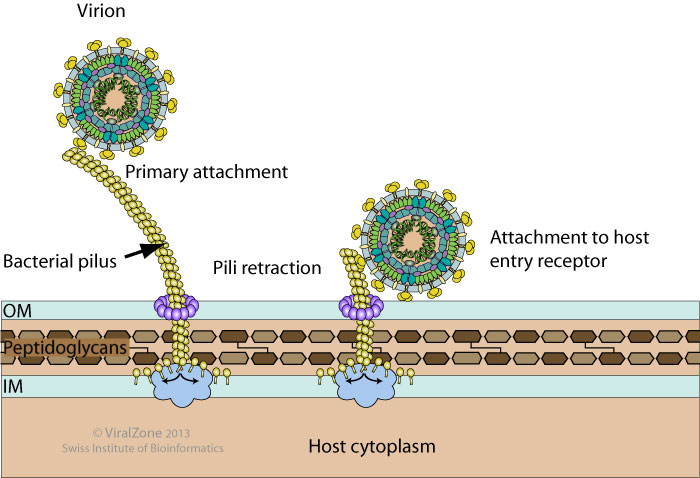Viral attachment to host cell pilus (kw:KW-1175)
Pili are proteic retractile filaments up to 20 micrometer long that protrude from gram-negative bacteria. Some RNA and DNA bacteriophages use pili to attach to the host cell.

There are many types of pili and each bacterial virus binds specifically to a precise type. Some filamentous viruses like bacteriophage fd adsorb onto the tip of F-pili and enter the cell at the pili basal pore. Other filamentous phages can target I-pili (phage If1), N-pili (phage IKe), or type IV pili (e.g. bacteriophages Pf1 and Pf3)  .
Icosahedral virus usually adsorb onto the sides the pili.
.
Icosahedral virus usually adsorb onto the sides the pili.
Identification and specificity of pilus adsorption proteins of filamentous bacteriophages infecting Pseudomonas aeruginosa.
Holland SJ, Sanz C, Perham RN
Virology. 2006 Feb 20;345(2):540-8
Holland SJ, Sanz C, Perham RN
Virology. 2006 Feb 20;345(2):540-8
Pseudomonas aeruginosa transposable bacteriophages D3112 and B3 require pili and surface growth for adsorption
C Roncero, A Darzins, M J Casadaban
J. Bacteriol. April 1990; 172: 1899?1904
C Roncero, A Darzins, M J Casadaban
J. Bacteriol. April 1990; 172: 1899?1904
Matching UniProtKB/Swiss-Prot entries
(all links/actions below point to uniprot.org website)17 entries grouped by protein
9 entries
Attachment protein G3P (Gene 3 protein) (G3P) (Minor coat protein)
4 entries
Maturation protein A (MP) (Assembly protein) (A protein)
3 entries
Maturation protein A2 (MP) (A2) (Assembly protein) (A protein)
1 entry
